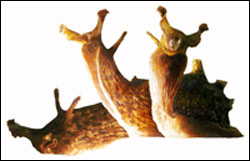Marine snail’s neural network sheds light on the basis for flexible behavior

Credit: Timothy Kang, Jin-sheng Wu and Jian Jing
From snail to man, one of the hallmarks of the brain is the ease with which behavioral variants are generated–for example, humans can easily walk with different stride lengths or different speeds. By studying how a relatively simple motor network of the marine snail Aplysia produces variants of a particular feeding behavior, researchers have found that the ability to generate a large number of behavioral variants stems from the elegant hierarchical architecture of the brain’s motor network.
Most motor systems are organized into a hierarchy of at least two layers of neurons, with higher-order neurons acting on lower-order neurons, which form a small number of building blocks or modules that produce a variety of behaviors. However, it was not clear how variants of a single motor act are generated in such a hierarchical system.
In the new work, Jian Jing and Klaudiusz Weiss of the Mount Sinai School of Medicine in New York studied the feeding network of Aplysia, which exhibits a biting behavior in response to the presence of food. The researchers showed that within the feeding network, two higher-order neurons that are active during biting behavior employ a combinatorial mechanism to produce variations in one particular movement parameter of the biting behavior. The researchers showed that, tellingly, these higher-order neurons accomplish their roles through their specific actions on two groups of lower-order interneurons that directly influence the particular biting-behavior movement parameter. Therefore, in this system, and likely others, the generation of large numbers of behavioral variants is characterized by higher-order neurons that flexibly combine an “alphabet system” of outputs that are generated by lower-order modules within the brain’s motor network.
Media Contact
More Information:
http://www.current-biology.comAll latest news from the category: Life Sciences and Chemistry
Articles and reports from the Life Sciences and chemistry area deal with applied and basic research into modern biology, chemistry and human medicine.
Valuable information can be found on a range of life sciences fields including bacteriology, biochemistry, bionics, bioinformatics, biophysics, biotechnology, genetics, geobotany, human biology, marine biology, microbiology, molecular biology, cellular biology, zoology, bioinorganic chemistry, microchemistry and environmental chemistry.
Newest articles

A universal framework for spatial biology
SpatialData is a freely accessible tool to unify and integrate data from different omics technologies accounting for spatial information, which can provide holistic insights into health and disease. Biological processes…

How complex biological processes arise
A $20 million grant from the U.S. National Science Foundation (NSF) will support the establishment and operation of the National Synthesis Center for Emergence in the Molecular and Cellular Sciences (NCEMS) at…

Airborne single-photon lidar system achieves high-resolution 3D imaging
Compact, low-power system opens doors for photon-efficient drone and satellite-based environmental monitoring and mapping. Researchers have developed a compact and lightweight single-photon airborne lidar system that can acquire high-resolution 3D…





















